#also FYI: i don't have a degree in this or nothing. I am a hobbyist victorian enthusiast. don't think anything is wrong in here especially
Explore tagged Tumblr posts
Note
what are your go-to resources for phantom blood fashion historical accuracy...... ...
ok I'm glad you asked this because I've been writing up a whole other post on dio's fashion sense and i wasn't sure how much of the period's fashion trends to explain since I didn't want to make an assumption that nobody knows anything about late victorian fashion. this will be a good reference post for me...and you... and anyone else who wants to use it.
regardless; I hate to say it but the best way to start drawing period clothing is to do a little reading on the fundamentals of [late] victorian dress because it will seriously assist you in the long run, e.g., you won't have to scratch your head and spend time wondering why you keep coming across two different lapel types on tailcoat fashion plates if you're aware that both peak tips and shawl collars were in vogue in the late 1880s and the '90s.
I'll put some basic information that I've collected for myself here so you don't have to go looking for it; I'm going to write this assuming you're a newborn baby deer poking your nose into the victorian era for the first time in your life fully unaware of the customs.
reference links for the wayfarer so you don't have to scroll all the way to the bottom:
Etiquette books. Look for anything written in the 80s/90s; again, period trends change. There's usually always a section on how men should be dressing on different occasions (weddings, funerals, daily casual travel, etc.) in these. In an ideal world one would only have to reference books written/published in London, however I've found that there are many more from US. This is fine though IMO, there was a lot of cross-talk between countries due to the implementation of the telegraph and hence a lot of etiquette standards are "universal" (it's why fashion between EU/US/AU can look pretty similar at the same time--they were all talking to each other). If there's a difference between the "New York" way of doing things and the "London" way of doing things, the authors usually point this out. kind of funny. I love reading these, they're also very good for understanding the general quirks of late Victorian society and how the standards at the time characterize their behavior.
The National Portrait Gallery (link is an advanced search; you can change the dates. I set the results to be located in "london")
Victoria & Albert museum online gallery
The Met museum online gallery (in general for clothes on mannequins, but they also list an archive of fashion plates here, separated by year. A lot of them are misfiled though so be wary of that)
Alamy website. genuinely one of the most all-encompassing resources I've used, I use it for everything and especially when I'm into period pieces. "boy 188*" "man 1880s portrait" "man 188* suit" etc. you find a lot of illustrations from the time period this way too. it fucking rules. my computer is on the brink of crashing 24/7 because I keep too many alamy tabs open at all times. A lot of really good Vanity Fair illustrations are on here too, just plug it in with a year and see what pops up.
Sites like this (Gentleman's Gazette) with little articles giving a run-down of period clothing can be helpful...... to an extent. idk. I don't really trust them. GG is solid for the most part and so is The Black Tie Blog and Victorian Web, but I've spotted too many errors on other sites to trust anything they say wholesale. Fashion Institute of Technology is worth mentioning as well, though, despite their coverage on men's fashion being pretty brief. Goes by decade, though, with a lot of information on women/children's fashion, too (it's very interesting! I linked their 1880s fashion rundown, highly recommend going through it, especially the Aestheticism segment). TL;DR: My advice when it comes to website hopping is "stick with primary sources".
How to Read a Suit (A Guide to Changing Men’s Fashion from the 17th to the 20th Century) by Lydia Edwards. Look this up on libgen. It's broken down into chunks of decades; REAAALLLYY recommend reading the introduction to "Chapter 4: 1860-1899". Probably the most historically informative consolidation of relevant fashion information in one place. Very interesting writing, pretty short too. If you're gonna read one thing out of this whole list, make it this.
The Dictionary of Fashion History by Valerie Cumming. look this up on libgen. for when you don't understand what some article or book is talking about and google will not give you answers. as it is it wont to do. (could not wrap my head around top frocks until this point; the wikipedia article for it is quite frankly embarrassing.)
here's my google drive of fashion for this time period, I had just been keeping these on local folders but I think drive would be better so I started transferring them here... compiled myself. this is a "work in progress" and will be updated.
I am going to write a bit about men's fashion at the time period under the cut because I think it's important to understand, if you don't know much about the victorian period, that the dress decorum was heavily emphasized and if you wore the wrong ensemble in the wrong setting everyone WOULD think you were ill-bred and would not invite you back into their home again. because just seeing you exist like that was impolite and quite frankly very embarrassing to witness. these resources are great but not if you don't know where and when these guys would be wearing these things... for instance i know the fashion plate archive there are some drawings of men in livery and you may be tempted to put dio in something like this because WOW! they do look kind of cool. with the big brass buttons... but I think he would more readily batter another human being physically than dress up like a butler at a dinner party and get mistaken for a butler. it's the little things.
first thing: you were expected to dress differently for different times of day. This consists of: morning dress, afternoon dress (semi-formal; not really "mandatory" except at special events, like weddings, at least for men), and evening dress (anything past 6 o'clock or "by candle light" is the general rule).

here are overview excerpts from Modern Etiquette in Public and Private published by Frederick Warne and Co. in 1887:
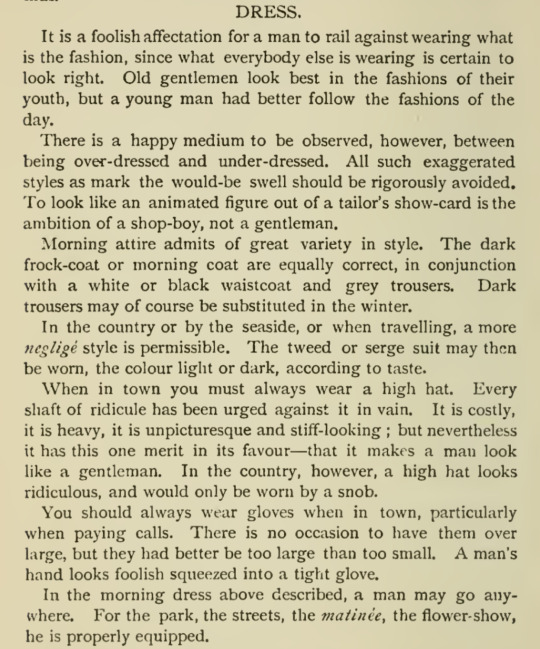
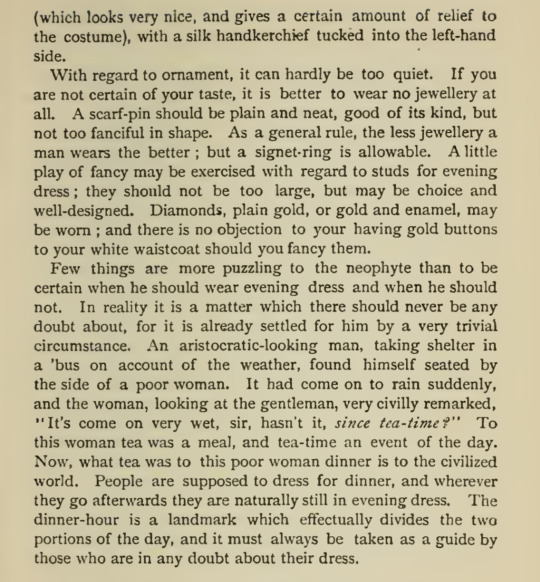
and excerpts from The Complete Bachelor: Manners for Men by Walter Germain, written in 1896:
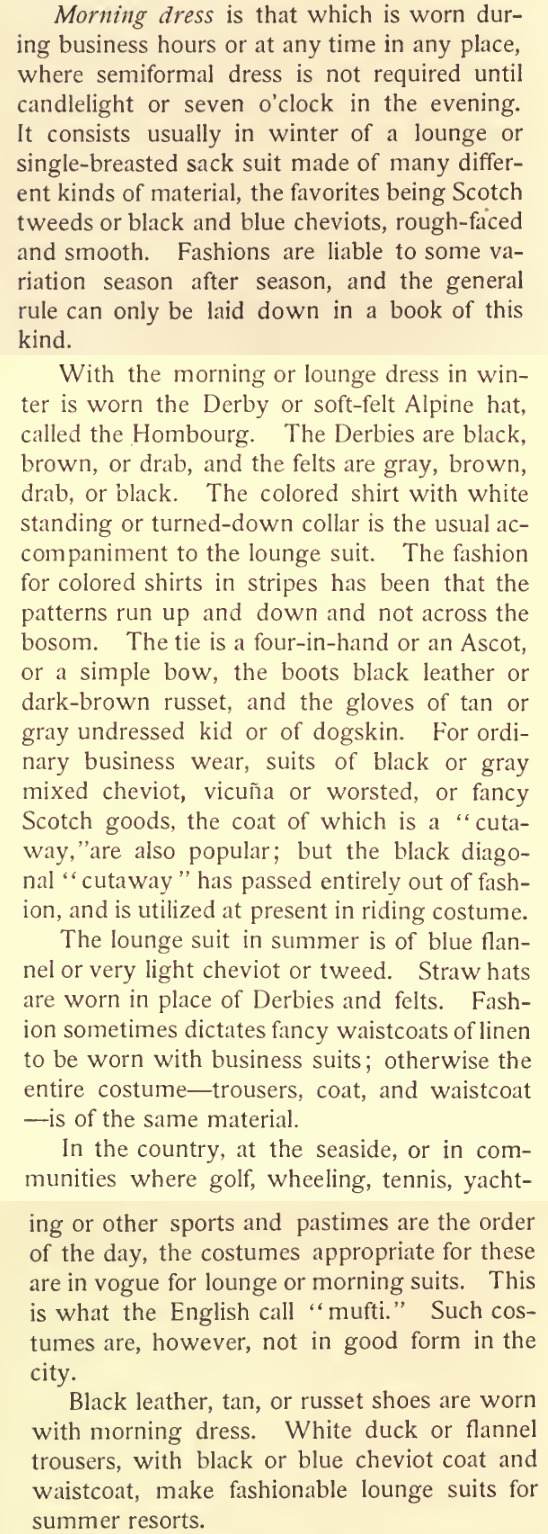

Cecil B. Hartley states in his Book of Etiquette and Manual of Politeness (1860) that "by dress we show our respect for society at large, or the persons with whom we are to mingle".
He advised men that there were “shades of being ‘dressed;’ and a man is called ‘little dressed,’ ‘well dressed,’ and ‘much dressed,’ not according to the quantity but the quality of his coverings.”
Black was "the" color. As Lydia Edwards writes in How to Read a Suit (2020), "while it is unrealistic to imagine that all men everywhere only wore black, the acceptable color palette was certainly more limited at this point than it had been for the first half of the century. The rising professional middle classes seemed to embrace a centuries-old association with black for certain professions, which perhaps made this an inevitable choice for the evolving and expanding world of work in the nineteenth century."
I'm going to add illustrations now; humbly request you ignore how terrible the paint canvases i threw things in. Things to note moving forward:
there were three different types of shirt collars in vogue at the time: stiff, high stand collars that hugged your neck, wing-tip collars, and one that's closer to the "regular" collars you typically see nowadays (banker collar). don't really see the last one in any of the fashion plates but you do see it in portraits.
Do note that walking sticks were commonplace and in fact expected to be touted around, hence why they (in addition to umbrellas) keep reappearing in the illustrations;



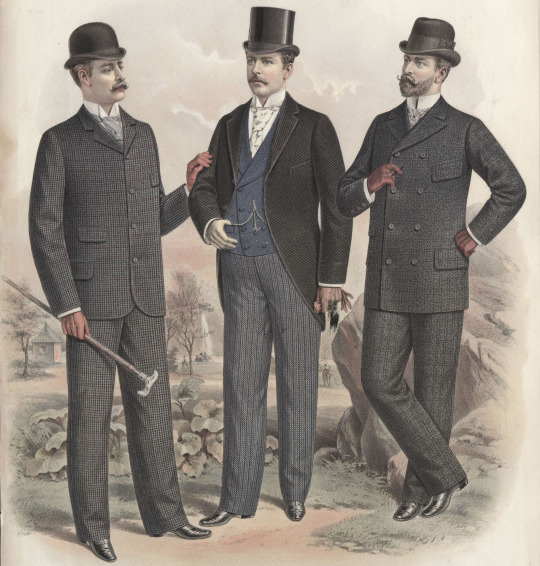
(1890)
Frock coats were the most "formal" of the daywear. When going through the National Portrait Gallery website you'll notice that most men are wearing either a morning coat or frock coat; the lounge coat was still too informal to be considered for how much money you'd spend to get a photograph taken. Don't you want to look nice?

Lounge suits, again, were the ultimate "informal"; they were viewed with distain by the frock-coat. (here's a good thread on this, actually; i love this fucking guy lol). really, really don't think Dio would be wearing one that often. maybe a double-breasted one? i really think he's too much of a snob to wear what he sees as filthy poor people rags. appearance is everything, etc.
~~~
waistcoats you have a lot of freedom/liberty with, at least in regard to design (except for evening waistcoats). different lapel shapes, no lapels... unfortunately shifting into the later decades of the 19th century it was pretty much expected that the fabric of your waistcoat match the fabric of your suit (along with your trousers; called a "ditto suit"). jonathan would conform to this mode IMO, i don't think it stops dio. he has a vision & his waistcoats are likely very extensively detailed. actually I just remembered that we do see one as depicted by araki's tenuous grasp of historical fashion and it is. awesome. i, too, love to wear cravats directly underneath my shirt


(1891 / 1892)
~~~
Evening dress is (comparatively) much more simple & men had much less artistic freedom in their choice of dress: black tailcoat, white gloves, white tie, waistcoat in either black or white, black button boots. Regardless, it was its own beast in the fact that this was something that you really weren't supposed to dick around with. (Dio would've found a way, but that's a discussion for a post that isn't crashing every 3 minutes.) From A Gentleman by Maurice Francis Egan (1893):
If a young man is invited to a dinner or to a great assembly in any large city, he must wear a black coat. A gray or colored coat worn after six o’clock in the evening, at any assembly where there are ladies, would imply either disrespect or ignorance on the part of the wearer. In most cities he is expected to wear the regulation evening dress, the “swallow-tail” coat of our grandfathers, and, of course, black trousers and a white tie. In London or New York or Chicago a man must follow this last custom or stay at home. He has his choice. The “swallow-tail” coat is worn after six o’clock in the evening, never earlier, in all English-speaking countries.
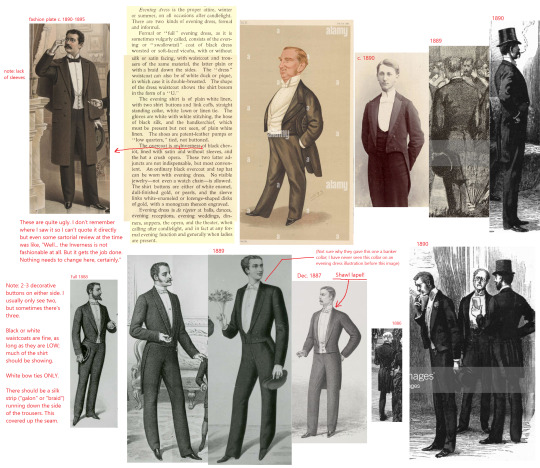
(1885 (misfiled) / 1888 / 1888 / 1890)



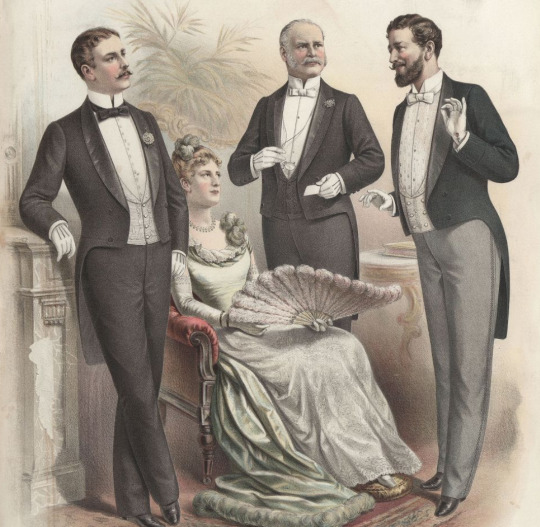
MET evening suit ca. 1888; different aspects of the ensemble displayed solo at this link.
In the 80s the "dinner jacket" ("tuxedo" in US) was introduced. It was used for more informal occasions.

final evening dress "tips":


~~~
Outerwear was pretty varied… you can get a pretty wide dynamic of form depending on choice of coat, so keep that in mind. chesterfields tended to be pretty formless, top frocks a bit more fitted. Length/density would change depending on season, too.

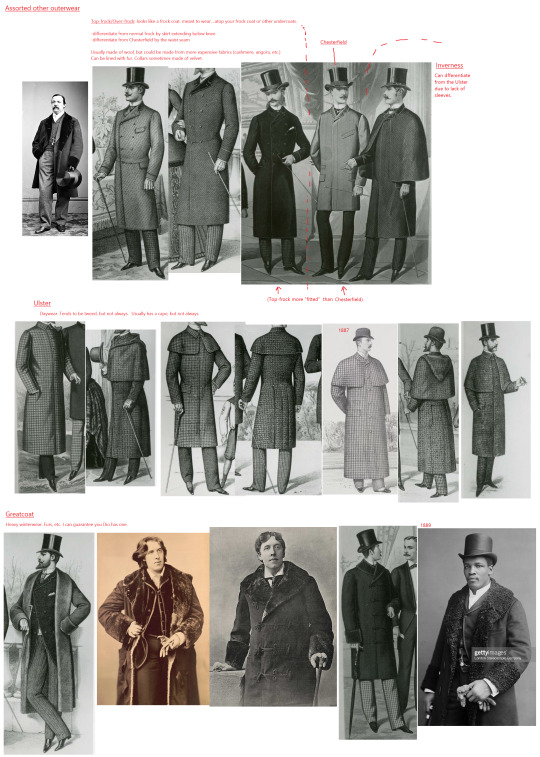
~~~
Children's fashion:


end notes:
everyone would be wearing suspenders, not belts; belts were pretty much only worn with military uniform at this time (except in america)
sweater vests were really only considered sportswear until the first few decades of the 1900s. they would not be wearing these casually under jackets, they'd be wearing waistcoats
button boots were buttoned using a special button hook. video demonstration
NOTE: trousers being "creased" began to be more in vogue in the 90s; this is because they finally invented the trouser press. read article for more information--you sometimes see creases in the 80s, really not before then though. look at how they bunch at the knee (c.1880s)!

When it comes to gloves, different colors denoted different occasions to wear them. In the text screenshots provided in previous sections, it usually states which colors are appropriate for whichever situation. The paragraph I am about to end this on is relatively useless, but I thought I'd include it anyway:

#ask#dio brando#jonathan joestar#phantom blood#I make myself sick going through fashion plates and the costume archives on museum websites identifying dio outfits regularly#that one image in the frock coat graphic reminds me so much of jeremy strong...kendall will get his day on ottiliere someday. but not today#I'll probably add to this post as I remember or discover more things to add. we're all on a journey of learning...together#posts that crashed one million times while editing#there was a lot more I wanted to add to this but every time i click something in here the entire post crashes. so i am leaving it#also FYI: i don't have a degree in this or nothing. I am a hobbyist victorian enthusiast. don't think anything is wrong in here especially#considering I cite sources but yaknow. <-disclaimer
62 notes
·
View notes